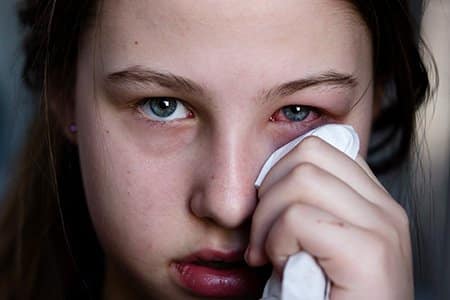This blog is part of a series of blog posts designed to serve as a quick reference guide. Each will focus on a sudden injury or illness and is designed to help you make an informed decision on a plan of action when the unexpected happens.
Bacterial conjunctivitis, commonly referred to as pink eye, is a bacterial infection that causes inflammation of the clear membrane that covers the white part of the eye. It can also lead to inflammation of the underside of the eyelid. The bacteria that cause pink eye can come from your own skin, your upper respiratory system, or from someone else with pink eye. It is very contagious.
What are the symptoms of pink eye?
- The normally white color of the eye is pink or red.
- The person experiences irritation, tearing, and some sensitivity to light.
- A thick, yellow discharge comes out of the eye. It may crust on the eyelids overnight, causing them to stick together. This discharge can also cause blurred vision. This discharge is the key symptom that signals a bacterial infection (other types of conjunctivitis are characterized by water discharge, if any).
How is pink eye diagnosed?
Bacterial conjunctivitis is diagnosed by your doctor, who will look for changes in the surface of your eye. If your case seems severe, your cornea is affected, or you have had repeat infections that have not responded to treatment, he or she may use a cotton swan to collect a sample of the discharge to be sent to a lab for further diagnosis.
How is pink eye treated?
Antibiotics are used to treat bacterial conjunctivitis. Most commonly, antibiotic eyedrops are used, but your doctor may also prescribe an ointment or pills instead. Your doctor may also recommend an eye wash or artificial tears to help ease discomfort.
In addition to antibiotic medication, what other ways can I treat bacterial conjunctivitis or pink eye at home?
- Apply a cool, clean, washcloth to your eye for 10-20 minutes, 3-4 times a day.
- Gently wipe away any drainage from your eye with a warm, wet washcloth or cotton ball.
- Stop wearing contact lenses until your doctor says it’s okay.
How can I keep pink eye from spreading?
Pink eye is incredibly contagious; it is easy to infect your family members or even re-infect yourself. Be sure to:
- Wash your hands often and use paper towels to dry your hands.
- Do not share towels or washcloths.
- Change or wash your pillowcase every day.
- Avoid using eye makeup until the infection is gone.
What other forms of conjunctivitis can cause similar symptoms?
Viral conjunctivitis is caused by a virus and is characterized by red, itchy, watery eyes. Unlike bacterial conjunctivitis, any discharge is usually clear. Antibiotic medications are not an effective form of treatment. Treatment is aimed at preventing a secondary bacterial infection and treating symptoms, such as itching.
Allergic conjunctivitis is caused by an allergic reaction to an allergen such as dust, mold, pollen, or animal dander. It results in red, itchy, watery eyes. Treatment usually involves allergy medication.
Chemical conjunctivitis is caused by exposure to an irritant or chemical substance and results in red, itchy, watery eyes. Common irritants include smoke, chlorine, soap, and air pollution.
Our Integrity Urgent Care locations are open daily from 8 am – 8 pm. Walk-ins are encouraged, and appointments are never necessary. We’re only a phone call away if you need more information.
Sources: https://www.cdc.gov/conjunctivitis/about/



